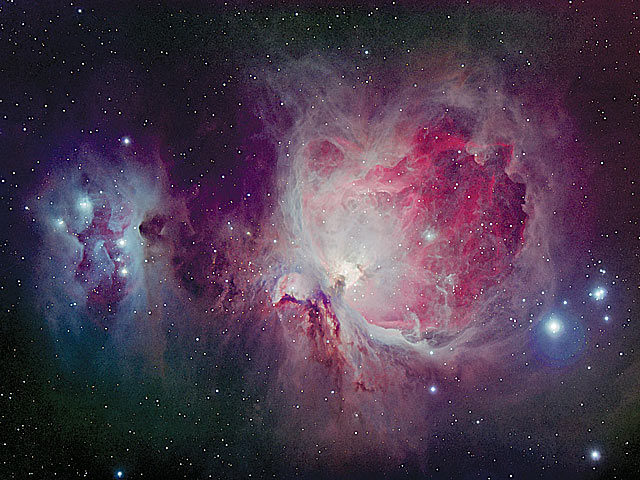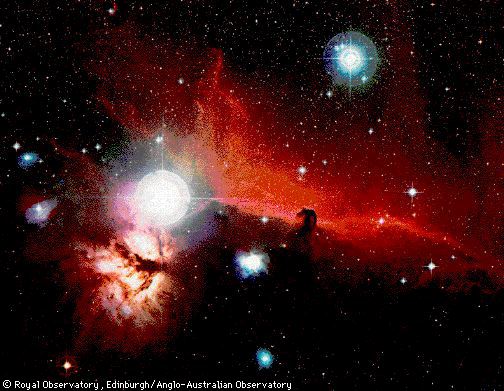Skip to comments.
Cosmic Bullets Pierce Space Cloud (Orion Nebula)
Space.com on Yahoo ^
| 3/22/07
| Ker Than
Posted on 03/24/2007 7:52:29 PM PDT by NormsRevenge
Astronomers just got their most detailed look yet at supersonic 'bullets' of gas piercing through dense clouds of hydrogen gas in the Orion Nebula.
Each bullet [image] is about ten times the size of Pluto's orbit around the Sun and travels through the clouds at up to 250 miles (400 kilometers) per second-or about a thousand times faster than the speed of sound.
The bulk of both the bullets and the surrounding gas cloud [image] consists of molecular hydrogen. The tip of each bullet is packed with iron atoms that are heated by friction and glow bright blue in the new image, taken by the Gemini Observatory in Hawaii.
As the bullets plow through the clouds, they leave behind tubular orange wakes, each about a fifth of a light-year long. A light-year is the distance light travels in a year, about 6 trillion miles (10 trillion kilometers).
The Orion Nebula is a young stellar nursery located about 1,500 light-years away. Scientists think our Sun was born in a similar environment some 4.5 billion years ago.
The Orion bullets were first spotted in a visible-light image in 1983, and followed up by infrared observations in 1992. Astronomers think the enormous clumps of gas were ejected from deep within the nebula following some unknown violent event about a thousand years ago.
'What I find stunning about the new image is the detail it shows, which was blurred out in any previous studies,' said Michael Burton of the University of New South Wales, one of the scientists who first suggested the origin of the bullets 15 years ago.
'This level of precision will allow the evolution of the system to be followed over the next few years, for small changes in the structures are expected from year to year as the bullets continue their outward motion,' Burton said.
The latest image of the Orion bullets was created with a new technology, called adaptive optics, which uses a laser guide star as a reference and a rapidly deforming mirror to correct image distortions from the Earth's atmosphere in real time.
TOPICS: Astronomy; Science
KEYWORDS: bullets; callingartbell; cosmic; moronickeyword; orion; orionnebula; pictures; pierce; spacecloud
Navigation: use the links below to view more comments.
first 1-20, 21-25 next last

This composite image at infrared wavelengths was obtained using the Gemini North laser guide star system in conjunction with the ALTAIR adaptive optics system and the NIRI near-infrared imager. The image shows the Orion "bullets" as blue features and represents the light emitted by hot iron gas. The light from the wakes, shown in orange, is from excited hydrogen gas. Gemini Observatory
--
Astronomy.com
March 22, 2007
Supersonic "bullets" in Orion
Excerpted
An image released today by the Gemini Observatory brings into focus a new and remarkably detailed view of supersonic "bullets" of gas and the wakes created as they pierce through clouds of molecular hydrogen in the Orion Nebula. The image was made possible with new laser guide star adaptive optics technology that corrects in real time for image distortions caused by Earth's atmosphere.
The Orion Nebula is a star-forming region located relatively near to us, about 1,500 light-years away. It's a young stellar nursery and shows many unusual features related to the effect of massive stars on the dense birth environment of gas and dust.
The Orion bullets were first seen in a visible-light image in 1983. By 1992, images taken at infrared wavelengths led astronomers to conclude that these clumps of gas were ejected from deep within the nebula following an unknown violent event connected with the recent formation of a cluster of massive stars there. The bullets are speeding outward from the cloud at up to 250 miles (400 kilometers) per second. This is more than a thousand times faster than the speed of sound. The name "bullet" is somewhat misleading since these objects are truly gigantic. The typical size of one of the bullet tips is about ten times the size of Pluto's orbit around the Sun. The wakes shown in the image about are about a fifth of a light- year long.
Clouds of iron atoms at the tip of each bullet glow brightly (blue in the Gemini image) as they are shock-heated by friction to around 9,000º Fahrenheit (5000º Celsius). Molecular hydrogen, which makes up the bulk of both the bullets and the surrounding gas cloud, is destroyed at the tips by the violent collisions between the high-speed bullets and the surrounding cloud. On the trailing edges of the bullets, however, the hydrogen molecules are not destroyed, but instead are heated to about 4000ºF (2000ºC). As the bullets plow through the clouds they leave behind distinctive tubular wakes (colored orange in the Gemini image). These wakes shine like bullet tracers due to the heated molecular hydrogen gas.
2
posted on
03/24/2007 7:56:40 PM PDT
by
NormsRevenge
(Semper Fi ...... BumP'n'Run 'Right-Wing Extremist' since 2001)
3
posted on
03/24/2007 8:03:28 PM PDT
by
NormsRevenge
(Semper Fi ...... BumP'n'Run 'Right-Wing Extremist' since 2001)

This infrared image from NASA's Spitzer Space Telescope shows the Orion Nebula, the closest massive star-making factory to Earth. Spitzer surveyed a significant swath of the Orion constellation, beyond what is highlighted in this image. Within that region, called the Orion cloud complex, the telescope found 2,300 stars circled by disks of planet-forming dust and 200 stellar embryos too young to have developed disks. NASA / JPL-Caltech / Univ. of Toledo
4
posted on
03/24/2007 8:06:19 PM PDT
by
NormsRevenge
(Semper Fi ...... BumP'n'Run 'Right-Wing Extremist' since 2001)
To: NormsRevenge
250 miles per second is hauling ass but still far short of light speed. I'm figgerin somewhere around 900,000 mph.
5
posted on
03/24/2007 8:07:40 PM PDT
by
cripplecreek
(Peace without victory is a temporary illusion.)
To: NormsRevenge
"Each bullet [image] is about ten times the size of Pluto's orbit"
Does that mean each object is that big? The earth's orbit is 93 million miles and Pluto's much larger. Are the objects hundred and hundred of millions of miles across?
6
posted on
03/24/2007 8:52:07 PM PDT
by
BenLurkin
To: BenLurkin
7
posted on
03/24/2007 8:53:03 PM PDT
by
NormsRevenge
(Semper Fi ...... BumP'n'Run 'Right-Wing Extremist' since 2001)
To: NormsRevenge
Still waiting for the Horse's Ass Nebula.
Cheers!
8
posted on
03/24/2007 9:06:34 PM PDT
by
grey_whiskers
(The opinions are solely those of the author and are subject to change without notice.)
To: grey_whiskers
LOL.. I'll Ping ya if I see it..
They may just be able to spot it if it's out there with this stuff.. Cool stuff. ;-)
Gemini Adaptive Optics Pages
9
posted on
03/24/2007 9:12:41 PM PDT
by
NormsRevenge
(Semper Fi ...... BumP'n'Run 'Right-Wing Extremist' since 2001)
Orion Nebula site:freerepublic.com
Google
10
posted on
03/24/2007 9:13:58 PM PDT
by
SunkenCiv
(I last updated my profile on Saturday, March 24, 2007. https://secure.freerepublic.com/donate/)
To: NormsRevenge; 75thOVI; AFPhys; Alice in Wonderland; AndrewC; Avoiding_Sulla; BenLurkin; Berosus; ...
11
posted on
03/24/2007 9:15:00 PM PDT
by
SunkenCiv
(I last updated my profile on Saturday, March 24, 2007. https://secure.freerepublic.com/donate/)
To: All
12
posted on
03/24/2007 9:16:47 PM PDT
by
NormsRevenge
(Semper Fi ...... BumP'n'Run 'Right-Wing Extremist' since 2001)
To: SunkenCiv
OOOooo.. Thanks
This was on one of the threads..

13
posted on
03/24/2007 9:20:38 PM PDT
by
NormsRevenge
(Semper Fi ...... BumP'n'Run 'Right-Wing Extremist' since 2001)
To: NormsRevenge
Just amazing!
You got some strange keywords with this one!
14
posted on
03/24/2007 9:20:39 PM PDT
by
Ernest_at_the_Beach
(The DemonicRATS believe ....that the best decisions are always made after the fact.)
To: Ernest_at_the_Beach
LOL... It's tough doing a straight science thread. ;-)
15
posted on
03/24/2007 9:23:40 PM PDT
by
NormsRevenge
(Semper Fi ...... BumP'n'Run 'Right-Wing Extremist' since 2001)
To: NormsRevenge
16
posted on
03/24/2007 9:34:28 PM PDT
by
Ernest_at_the_Beach
(The DemonicRATS believe ....that the best decisions are always made after the fact.)
To: NormsRevenge
Having Old Crusty in the Title really gets everyone stirred up too....referring tothe earlier thread....
17
posted on
03/24/2007 9:35:42 PM PDT
by
Ernest_at_the_Beach
(The DemonicRATS believe ....that the best decisions are always made after the fact.)
To: NormsRevenge
Huge! No.. HUGH!!!!!

18
posted on
03/24/2007 9:46:05 PM PDT
by
NonLinear
(This is something almost unknown within Washington. It's called leadership.)
To: NormsRevenge
19
posted on
03/24/2007 9:50:08 PM PDT
by
Fiddlstix
(Warning! This Is A Subliminal Tagline! Read it at your own risk!(Presented by TagLines R US))
To: NormsRevenge
The longer I live the stranger and more wonderful it all becomes.
Navigation: use the links below to view more comments.
first 1-20, 21-25 next last
Disclaimer:
Opinions posted on Free Republic are those of the individual
posters and do not necessarily represent the opinion of Free Republic or its
management. All materials posted herein are protected by copyright law and the
exemption for fair use of copyrighted works.
FreeRepublic.com is powered by software copyright 2000-2008 John Robinson




